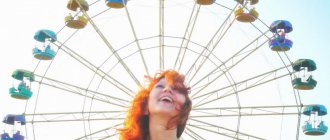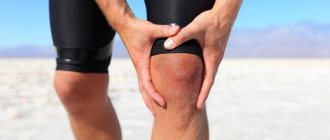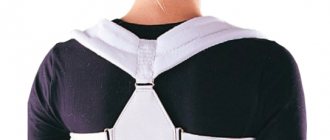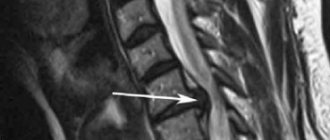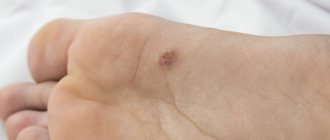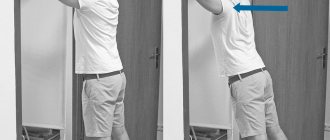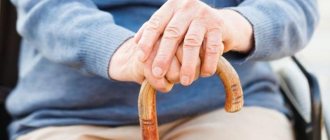What effect does physiotherapy have?
First of all, physiotherapy can be either an addition to therapy or the main form of treatment. Prescribing physiotherapy for osteochondrosis is necessary to solve certain problems and achieve goals, which include:
- reduction of pain syndrome;
- normalization of metabolic processes;
- improved blood circulation;
- normalization of motor functions;
- providing tissues with the nutrition necessary to activate regenerative properties;
- reduce the amount of medications consumed;
- eliminate the source of inflammation;
- strengthen the patient's immune system.
All these effects are achieved through the action of the properties of transformed forms of energy. Procedures are prescribed taking into account the stage of the disease and the characteristics of its course.
Active treatment is indicated only during periods of remission, and during exacerbation of the disease it is recommended to use methods that are aimed at achieving an analgesic effect.
Principle of operation
MLS pulse has extremely high biological and therapeutic qualities.
The idea that light has healing properties is widespread in modern culture, especially since it has been considered the source of life for centuries. No living organism can do without light: plants receive energy directly from the sun's rays through photosynthesis. Light regulates the biological rhythms (sleep, walking) of most living creatures, which can absorb it due to the presence of special photoreceptors. To date, it has been scientifically proven that certain types of radiation can effectively transfer energy to animal cells and tissues. As a result, metabolism is normalized in problem areas, and damaged tissues are restored.
However, not all types of radiation are equally effective and lead to the same therapeutic result. In fact, each radiation has precise physical parameters on which the nature of the “vibration” of the electromagnetic field depends. It is these parameters that determine whether a given radiation is capable of transferring energy to tissues or not.
MLS therapy became possible after the most effective waveform was established. The synergistic effect of MLS therapy is achieved due to the physical characteristics inherent in the MLS pulse. It is a special complex type of radiation that transmits the energy of the electromagnetic field to tissues in the most effective way. Thus, this light pulse has maximum biological and therapeutic qualities and is generated through a synchronized combination of pulsed and continuous lasers with waves of different lengths. The MLS pulse was developed taking into account the most current information presented in the medical literature and the results of rigorous research showing that the primary biochemical and bioelectrical effects of such radiation are much more effective.
The course of treatment is prescribed and carried out by a doctor in each individual case. The session lasts no more than 20 minutes.
Types of physiotherapy in the treatment of osteochondrosis
Modern physiotherapy offers the following methods of influence:
- use of ultraviolet radiation;
- laser treatment of affected areas;
- vibration method, which includes massage and sound waves;
- direction of flow of electrical impulses;
- use of mud baths;
- use of sound waves.
Electrotherapy
It is considered one of the simplest and most accessible methods of physiotherapy, due to which it is very popular. The essence of the method is to influence the affected tissues with an electric field, which increases blood circulation and creates a feeling of warmth in the tissues.
Diadynamic therapy
This is a method that is based on the use of diadynamic currents with a frequency of 50 and 100 Hz and a trailing edge decaying exponentially. These currents have a complex reflex effect on the body, thereby causing therapeutic effects:
- trophic;
- anesthetic;
- vasoactive;
- myoneurostimulating.
The patient experiences a sensation of tingling, slight burning, warmth, or vibration.
Interference therapy
A method in which the body is exposed to two or more alternating currents. These vibrations are applied in such a way that they overlap each other deep in the tissue.
One of the currents has a constant frequency of 5000 Hz, and the second varies in the range from 3000 to 5000 Hz. At the point where they intersect, a new current is formed with a variable frequency from 0 to 100 Hz.
The initial currents pass through the skin without causing any discomfort. They can only appear at the point where vibrations overlap. The “beating” that occurs at the site of impact has a stimulating effect on the nerves and muscles, which is why the smooth muscles of the internal organs begin to contract.
This is a bit like a massage, and as a result, blood supply improves, the pain area is blocked, because when the brain is exposed to alternating currents, opioid peptides are produced, which have an analgesic effect.
The main difference from other similar methods is that therapeutic currents are generated inside the patient’s tissues, and not using devices. The disadvantage of therapy is considered to be rapid addiction.
Drug electrophoresis
It is a method that includes the complex effect of electric current (active factor) and a drug that enters the body with the help of current.
Drug electrophoresis has a number of advantages over other methods of introducing drugs into the body. For example:
- the drug enters directly into the tissues of the lesion, creating a high concentration there, without saturating the entire body;
- with electrophoresis, negative reactions to administered drugs are less likely to occur, and fewer side effects occur;
- the substance is introduced into the body not in molecular form, but in the form of individual ingredients (this increases its pharmacological activity, and ballast substances do not enter the body);
- To administer the drug, it is not necessary to violate the integrity of the skin, so there is no need to sterilize the drug.
Before starting therapy, you need to understand that there are certain contraindications, in the presence of which it is better to avoid using this method:
- the presence of chronic kidney and liver diseases;
- presence of tumors;
- heart attack or stroke;
- the presence of purulent inflammation of internal tissues and organs;
- presence of Parkinson's disease or multiple sclerosis;
- in the presence of epilepsy;
- heat;
- for acute bleeding;
- the presence of tuberculosis in the acute phase.
Shock wave therapy (vibration therapy)
This physiotherapeutic procedure is based on the effects of low-frequency acoustic waves. The first application of this method was to crush kidney stones. Subsequently, doctors thought that in this way they could influence not only stones, but also bones.
The procedure is carried out on an outpatient basis in a physiotherapist's office. The specialist conducts an examination and selects the optimal treatment option, after which he applies a special gel to the diseased area, which improves the passage of the acoustic wave and applies the tip of the UVT device to the skin.
The procedure is felt as a dull tapping at the site of inflammation. In the case of a severe inflammatory process, slight jolting pain may occur. The full course includes about 5-7 procedures, and the duration of one procedure is no more than 7 minutes.
Due to the fact that shock wave therapy has an active effect on body tissue, there is a list of contraindications:
- pregnancy;
- neoplasms near the affected area;
- the presence of blood clots in the heart area;
- diseases with blood clotting disorders;
- if you have a pacemaker;
- in acute infectious processes.
ShT is not prescribed for children, since their skeleton is not yet formed, and is also not recommended for people who have just been ill and their body has not yet recovered.
The effect of therapy is evident after 2-5 visits - patients begin to notice a subsidence of painful sensations and an increase in the mobility of the affected limbs.
Detensor therapy
It is a method of gentle traction of the spine. For this, a special mat is used with elastic ribs that fit the body and follow its contours when a person lies on the mat.
At this moment, the body pressure is distributed, tensile forces appear, which are directed along the body - the spine begins to stretch, the load is removed from the intervertebral discs, and the muscles relax.
Therapy has the following effects on the body:
- increases the intervertebral space, due to which the nerves begin to receive more nutrients;
- damaged disks are restored;
- the spine receives unloading;
- blood circulation improves;
- the person does not experience pain.
Detensor therapy has its advantages:
- safety;
- the effect appears quickly;
- helps even in the presence of very severe pain;
- the functioning of the organ system and well-being improves.
Detensor is the name of the mattress itself, the design of which is similar to a system of inclined ribs directed on the sides from the center. Due to its elasticity, the mattress can adapt to a person’s structure, so that the spine is always in a neutral position.
The session lasts 45 minutes. At first, the patient will experience nagging pain in the shoulder girdle or lower back. At the end of the procedure, the discomfort will go away and you will not be able to sit down for another hour after the procedure. The full course consists of 12 procedures.
The great advantage of the procedure is that it has no contraindications - even pregnant women and children can use it.
Laser therapy
The method consists of treating osteochondrosis using laser radiation in a very small range, which is safe for humans. The effect is achieved through the interaction of quantum particles of electromagnetic radiation and the biological structures of cells.
To maximize the effectiveness of the procedure, several principles should be taken into account:
- complexity of impact;
- sufficiency of the dose, which is determined for each patient individually;
- changing radiation parameters during treatment.
Osteochondrosis is treated with red light radiation - this happens due to the fact that at this wavelength, the light can penetrate the tissues most deeply - the beam must affect all structures that are located above the surface of the skin.
Laser therapy leads to the following results:
- the spasm of the muscle layer cells is relieved;
- the lumen of the arteries expands;
- the level of oxygen in the blood increases, thereby reducing hypoxia;
- the functioning of the nervous system is normalized;
- the outflow of lymph and blood improves.
Laser therapy can be performed using several methods:
- locally, placing the emitting head directly on the area of change in tissue structure;
- to special points, which are also used in acupuncture;
- by segment, but taking into account relationships with neighboring bodies;
- on nerve fibers and structures, but the light guide is placed in the projection of large neurovascular bundles.
The use of a laser is considered not the safest method, so the procedure may lead to some complications:
- dizziness or loss of consciousness may increase;
- Symptoms of the disease may increase after the start of the procedure.
Laser therapy is also not prescribed if the following contraindications exist:
- presence of tumors;
- exacerbation of infectious diseases;
- thyrotoxicosis;
- vascular lesions;
- hemorrhagic stroke;
- severe diseases of internal organs;
- mental illnesses, especially those that can result in seizures;
- hormonal disorders and endocrine imbalance;
- blood pathologies.
If you have such problems with your body, you should avoid using laser therapy, as the potential harm will outweigh the possible benefit.
Balneotherapy
It is a treatment with mineral waters. Suitable for both prevention and treatment of various diseases. Unlike conventional hydrotherapy, balneotherapy uses mineral water, thermal or natural.
Mineral waters are considered to be waters that contain a high concentration of mineral and organic chemical elements, and they have some physical properties. Thermal waters are waters whose temperature ranges from 37 to 42 degrees.
To maintain the therapeutic effect, treatment should be carried out exclusively under the supervision of doctors, since various salts, elements and other components can irritate the skin, excite the nervous system, and increase blood circulation.
To achieve results, you should undergo a 2-3 week course of balneotherapy. At the same time, the duration and number of procedures in the course will depend on the recommendations of the doctor and the resort.
Treatment with mineral waters is prohibited if the following contraindications exist:
- acute or chronic processes;
- predisposition to bleeding;
- presence of tumors;
- tuberculosis;
- allergy to mineral water components;
- heart diseases;
- poor blood clotting;
- epilepsy or diseases of the nervous system.
Magnetotherapy
This method is based on the influence of a magnetic field with a constant frequency. The duration of one such procedure should not be longer than 20 minutes. The magnetic field inductors must be placed opposite each other so that the part of the spine affected by osteochondrosis is located in the center of a strong magnetic field.
There will be no reactions, everything happens at the cellular level, which is why the absence of a quick result or any manifestations does not inspire confidence in this technique.
Using the method helps eliminate inflammation and relieve pain. You can carry out the procedure at home using a special device called a tape recorder.
More information about this type of physiotherapy can be found here.
Ultraviolet irradiation
Ultraviolet rays help our skin synthesize vitamin D, which promotes the absorption of calcium, which is necessary to maintain the structure of cartilage and bone tissue.
For this purpose, ultraviolet irradiation is carried out using special irradiators that have bactericidal and anti-inflammatory effects:
- For cervical osteochondrosis, UFO physiotherapy is applied locally on the back of the neck and on the upper part of the shoulder blades, as well as on the outer surface of the shoulder.
- If you have osteochondrosis of the lumbar region, they affect the lumbosacral and gluteal region, as well as the back of the thighs and legs.
- For osteochondrosis of the thoracic region, the midline of the spine in the sternum area is affected.
Before starting therapy, the patient is tested for sensitivity to rays with the smallest biodoses. Usually 10 to 15 sessions are prescribed.
Acupuncture
This is a treatment method, the essence of which is to use thin needles on acupuncture points, of which there are more than 600 on the human body. Each point is a tangle of nerve endings, plexuses of blood vessels and connective tissue. If such a structure is launched, then metabolic processes are activated, which are regulated by the activity of internal organs.
During acupuncture, the following processes begin to occur in the body:
- endogenous opiates (enkephalins and endorphins) are produced;
- blood circulation is normalized;
- cortisol is produced due to activation of the adrenal cortex;
- swelling of the spinal nerves decreases;
- the regenerative properties of cartilage tissue are improved;
- spasms of paravertebral muscles are reduced.
But there are also a number of the following contraindications to acupuncture:
- the procedure is prohibited for children under 3 years of age and elderly people over 75 years of age;
- pregnancy;
- tumors;
- skin and blood diseases;
- infectious diseases.
Side effects that may occur during the procedure include:
- formation of a hematoma at the site of needle insertion;
- tissue infection when using untreated needles;
- painful sensations during needle insertion.
If the patient experiences nausea, dizziness or chills during the procedure, it should be stopped immediately.
Ultraphonophoresis
This is the complex effect of ultrasound and a medicinal product applied to the skin. For ultraphonophoresis, glucocorticoid hormones, antispasmodics, vasoregulatory drugs, and antibiotics are mainly used, since they are able to potentiate the main therapeutic effects of ultrasound.
The drugs are administered through the excretory ducts of the sweat and sebaceous glands. Transcellular and intercellular routes of penetration are also possible. The ultraphonophoresis technique does not differ significantly from the ultrasound therapy technique. The substance that enters the contact medium can be prepared in the form of an emulsion, ointment or medicinal solution.
Contraindications to the use of phonophoresis are individual intolerance to medications, as well as contraindications to ultrasound itself.
Amplipulsetherapy
Another method of physiotherapy, the essence of which is to influence the patient’s body with sinusoidal currents. During the procedure, electromagnetic oscillations are modeled by amplitude, which is where the name came from.
The main instrument of amplipulse therapy is alternating current with a frequency of 5-10 kHz, which penetrates well under the skin and reaches deep-lying tissues. All this leads to the formation of a series of pulses similar to a beating and having an exciting effect.
As a result, a focus of irritation appears in the nervous system, which suppresses the dominant pain, increases the production of endorphins, and blood flow to all organs.
The method has its contraindications:
- thrombophlebitis;
- purulent inflammation;
- decompensated vascular diseases;
- general circulatory disorders.
The following devices are used for amplipulse therapy:
- Aplipulse 4,5,6,7 episodes.
- El Aesculapius Med TeCo.
- AFT SI-01-MicroMed.
Darsonvalization
Darsonval is a special device whose operating principle is based on the use of low-power pulsed high-frequency current. The impact power can be adjusted, since the configuration of the electrodes varies.
Darsonvalization is used for the following factors:
- restoration of normal blood supply to spinal tissues;
- improving metabolism in spinal tissues;
- improving the transmission of nerve impulses;
- restoration of skin sensitivity.
The duration of one procedure is about 15 minutes at medium or high power. The procedures must be carried out every other day, and the course of treatment consists of 20 procedures.
Contraindications to darsonvalization include:
- pregnancy;
- increased skin sensitivity;
- malignant and benign tumors:
- presence of a pacemaker;
- high body temperature;
- epilepsy;
- tuberculosis;
- heart and vascular diseases;
- thrombophlebitis.
results
Group 1 consisted of 20 patients (5 men, 15 women). Group 2 consisted of 25 patients (8 men, 17 women). Group 3 consisted of 20 patients (9 men, 11 women). There were no statistically significant differences in gender distribution for the study. The mean age was 58.4 ± 10.76 years in group 1, 61 ± 10.47 years in group 2, and 54.6 ± 14.89 in group 3. There were no statistically significant differences in age for the study (P>0.05).
Lumbar MRI findings of 65 patients with lumbar disc herniation were reviewed. Fifty-three of these patients had disc protrusion at one or more levels, and 12 had disc extrusion. Thirty-two of the 65 patients had compression of nerve endings at one or more levels. There were no significant differences regarding the presence of compression of nerve endings and the degree of disc herniation. When comparing parameters in group 1 before the start of therapy and at the end of therapy, significant changes in VAS (visual analogue scale), Oswestry scaled score, BP (body pain), GH (general health), VT (vitality) and SF (social functioning) (P<0.05). There were no significant changes in PF (physical functioning), RP (physical disability), RE (emotional disability) and MH (mental health) (P>0.05). Changes in the Oswestry scaled score and PF, BP, GH and VT in the third month after the end of therapy compared with the indicators immediately after the end of therapy were statistically significant (Table 1).
When comparing parameters in group 2 before the start of therapy and at the end of therapy, significant changes in VAS scores, Oswestry scaled score and PF, RF, BP, GH, VT, SF, RE and MH scores were revealed (P<0.05). When comparing indicators at the third month after the end of therapy with indicators immediately after the end of therapy, statistically significant changes were identified with regard to the Oswestry scaled score and PF, BP, GH and MH indicators (Table 1).
When comparing parameters in group 3 before the start of therapy and at the end of therapy, significant changes in VAS scores, Oswestry scaled score and PF, RP, BP, GH and RE scores were revealed (P<0.05). The VT, SF and MH indicators in group 3 did not undergo significant changes (P>0.05). When comparing the scores at the third month after the end of therapy with the scores immediately after the end of therapy, statistically significant changes continued to be observed in relation to the Oswestry scaled score and BP and GH scores.
When comparing changes in parameters in different groups, a statistically significant difference was observed regarding the MH indicator between groups 1 and 2 before the start of therapy and regarding the MH indicator and VAS score between groups 2 and 3 at the third month after the end of therapy. However, when assessing the condition of patients after 10 days of therapy, no significant differences were revealed compared with baseline indicators (Table 1).
Indications and contraindications
Indications for physiotherapy in the treatment of osteochondrosis:
- with radicular syndrome (compression of the spinal roots);
- intervertebral hernias;
- limited mobility of the spinal column.
Although physical therapy has a wide range of uses, it should be understood that it is not suitable for all people. Under each type of therapy, we considered contraindications to them, however, general groups can be distinguished:
- cancer patients;
- pregnant women;
- people under the influence of alcohol or drugs;
- acute forms of diseases;
- mental disorders;
- skin diseases;
- pathologies of the cardiovascular system.
Despite the huge choice of physical therapy methods, you should not attempt such treatment on your own. Only a doctor is able to assess the feasibility of such measures, as well as analyze the results of treatment.
Benefits of laser therapy
Laser therapy is in demand among doctors of various specialties. The list of advantages of this procedure includes:
- versatility: suitable for solving a wide variety of medical problems;
- relatively few contraindications;
- painlessness: treatment does not require pain relief;
- no damage to the skin (except for the technique of intravenous laser irradiation of blood);
- affordable price;
- lack of long-term training and rehabilitation;
- the possibility of combination with other physiotherapeutic procedures, medication and surgical treatment.
Intervention Details
Currently, in all countries with developed medicine, for example, the USA, Israel, Germany, and the Czech Republic, there are three main methods of laser treatment for herniated intervertebral discs. This:
- laser vaporization, in which part of the disc that represents a hernia or anatomical defect is evaporated.
When carrying out laser vaporization, the skin, subcutaneous tissue, superficial muscles and ligaments of the spine in the required segment are anesthetized. Then the soft tissue is punctured, and a hollow, semi-rigid needle, covered with a mandrel and capable of bending, is passed through the intervertebral foramen to the required disc.
After the required location is reached under optical control, a thin laser LED is passed along it, at the end of which there is a powerful infrared laser that emits a certain amount of energy. In the same tube there is also a free channel through which the resulting vapors should be discharged back after the boiling of the water entering the disc cartilage. Drawing an analogy with a firearm, this is a channel for the removal of powder gases. It is needed so that the pressure in the area of operation of the high-energy laser does not increase.
As a result, the size of the hernia decreases, intradiscal pressure also decreases, and often right on the operating table the patient reports the complete disappearance of pain.
In simple terms, vaporization is the drying of a hernia with a powerful laser, reducing its volume, while reducing the pressure and level of pain.
- The second type of minimally invasive laser surgery is laser reconstruction.
In this case, such high energy radiation is not created, and the hernia does not evaporate, but only changes the structure of the disc. The laser moderately heats the cartilage tissue to approximately 70 degrees Celsius.
Laser reconstruction is a more “humane” method of treatment. If during vaporization there is destruction and evaporation of tissue that is no longer good for anything, then laser reconstruction is used in cases where there are no large protrusions and hernias, but according to tomography there are many cracks in the disc, and they can cause future ruptures of the fibrous ring .
Due to the heating of the intervertebral disc, it receives an additional stimulus to heal these cracks. In simple terms, the disk “sticks together”, and the cause of this phenomenon is considered to be the cavitation effect, or the formation of microbubbles. After this treatment, the cartilage does not improve its structure immediately, but over several months. But the pain and risk of hernia formation decreases after 3 months.
Reconstruction is a therapeutic attempt to restore the disc using low power laser light. Therefore, if the hernia is large, or calcified, or the fibrous ring has already ruptured, then this method will be useless.
